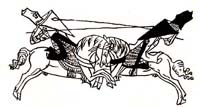 |
Polemics

  | Something Borrowed, Nothing New |   |
Marian T. Horvat, Ph.D.
Published in The Remnant, October 31, 2001
The recent declaration Dominus Jesus issued by the Congregation for the Doctrine of the Faith last September 5 has been the object of much misinterpretation. The mass media made a strong effort to insist that the document signified a return to the pre-Vatican II “dark ages” and the “archaic” doctrine Extra Ecclesiam nulla salus [No salvation outside the Catholic Church]. Present-day ecumenism would be condemned; the unicity of the Catholic Church would be reaffirmed; all the post-conciliar advances achieved by 40 years of efforts moving toward a new Universal Religion would be lost, and so on...
Some conservatives who follow the school of "blind obedience" to everything that issues from the Vatican took their place in the applauding bandwagon. And, following their general pattern, their enthusiasm for the document is translated into an attempt to excommunicate whoever will not agree with their “infallible” interpretation. In this article I would like to present some evidence that speaks in the exact opposite sense of the bandwagon.
For not everyone is reading Dominus Jesus according to this diktat of the media. In a letter dated September 10 sent to the Boston Globe, Kent R. Hill, President of the Eastern Nazarene College and a Protestant participant in the “Evangelicals and Catholics Together” project, noted that when he saw the press reports, he was very worried. However, after a careful reading of the document, he realized that there was no basis to such exaggerated claims in the secular press which had asserted that John Paul II had somehow “allegedly abandoned his earlier ecumenism and is moving the Catholic Church back towards ‘pre-Vatican II triumphalism.’”
Au contraire, he exclaims with that particular post-Vatican II brand of triumphalism, “the quotations actually contend that even we Protestants who ‘have not preserved the valid Episcopate,’ but have been baptized, are ‘incorporated in Christ and thus are in a certain communion, albeit imperfect, with the Church.’”
“This position,” he sighs with relief, “is completely faithful with the ecumenism of Vatican II, and is seen as a gesture of good will by most Protestants who appreciate the affirmation that the grace of God extends beyond the membership of the Catholic Church. He continues, "In addition, the full document insists that there are true elements in the sacred writings of other religions, which have enabled people both in the past and the present to nourish and maintain their life-relationship with God.”
Fr. Richard McBrien is one who can always be counted on to decry and censure any return to tradition and “the pre-Vatican II era when the Catholic Church claimed without qualification to be ‘the one, true Church’ and when the salvation of non-Christians was regarded as chancy at best.” Perhaps it will be surprising to some that Fr. McBrien was benevolent – although not enthusiastic – with regard to Dominus Jesus. In brief, he said, when you read it in context, “the document could conceivably have been written on the day after the Second Vatican Council adjourned in December 1965.”
While the document could have been more positive in tone, he asserts with a certain irony, it nonetheless does not limit “faith” to Christians. And it is possible “for a Christian to have faith in Jesus as the Son of God and as the Redeemer of all humankind and at the same time to affirm that the love and saving will of God extends to all the peoples of the world. The Second Vatican Council was not alone in saying so. When one actually reads the text, so does Dominus Jesus.” (“The Vatican and non-Christians,” The Tidings, Los
Angeles, Sept. 29, 2000, p. 11)
In one of his latest columns, author George Weigel also thought it appropriate to “clear the air” after the “obtuse reporting” that accompanied the release of this Vatican statement. Who better than convert Father Neuhaus, who has forty years of ecumenical activism under his belt, to set us straight? he asks. Fr. Neuhaus firmly denies that Dominus Jesus was a major ‘setback’ to Christian unity and a reassertion of the ‘pre-Vatican II teaching’ that only Catholics can be saved. He, along with Southern Baptist theologian Dr. Timothy George, dean of Beeson Theological Seminary, has correctly read Dominus Jesus as “a ringing affirmation of the uniqueness… and universality of the Gospel of Jesus Christ.”
And as for ecumenism, Fr. Neuhaus states, “The declaration says that since there is only one Christ, there can be, in the deepest sense of the term, only one Church, which is the Body of Christ. It reiterates the language of Vatican II that the one Church of Jesus Christ ‘subsists in’ the Catholic Church.” (George Weigel, “Clearing the air after Dominus Jesus,” The Tidings, LA, October 6, 2000, p. 11)
Post-Vatican II ecumenism is alive and well, and inter-religious dialogue can proceed as normal. Which is exactly what Baltimore’s Cardinal William Keeler, who was present at the September 5 Vatican news conference, told reporters afterward: that he felt the document posed no obstacle to inter-religious dialogue. (“Exclusive Claim,” National Catholic Reporter, Sept. 15, 2000, p. 7)
In fact, two days after the release, Pope John Paul II welcomed the new ambassador from Egypt, reiterating his wishes “for a new era of religious and cultural dialogue between Islam and Christianity.”
In his address, which emphasized how religious differences are “enriching,” the Pope said that believers “who worship the one God, who look to Abraham as a Holy Patriarch and who seek to follow the Law of Sinai” should try to find “the things we have in common.” There was certainly no indication of any change of direction in the ecumenical route charted and embarked on so decidedly by John Paul II.
New interpretations of the document began to circulate with insinuations that there could be a difference of opinion between the Pope and Cardinal Ratzinger. That these media theatrics were unfounded became clear early this month. John Paul II firmly closed the door on such speculations with the words he spoke before reciting the Angelus on October 1. After a Mass celebrated for the canonization of yet another 123 Saints, the Pontiff pointed out that he is entirely supportive of the document.
According to him, the declaration does no more than follow Vatican Council II, which does not deny salvation to non-Christians, “but explains its ultimate source in Christ.” He defended Dominus Jesus as a document that reaffirms the Vatican II teaching that “the one Church of Christ subsists in the Catholic Church. …
Thus the document expresses once again the same ecumenical passion that is at the basis of my encyclical Ut Unum Sint. It is my hope that, after so many mistaken interpretations, this heartfelt declaration will finally be able to achieve its clarifying function, as well as that of openness.” (Pope’s Words before the Angelus, October 1, Zenit Internet Dispatch)
Thus, so that there be no confusion, the Pope himself asserted that the document establishes a clear distinction between the Church of Christ and the Catholic Church. Borrowing the thesis and words from Lumen Gentium (8b), it thus affirms that the Church of Christ would be broader than the Catholic Church, which would subsist in her, without being confused with her. This distinction clashes with the perennial doctrine of the Catholic Magisterium as demonstrated by Atila Sinke Guimarães (see In the Murky Waters of Vatican II, Chap. 1), and recently reaffirmed in his article “A Conversion?” (The Remnant, September 30, 2000).
Finally, in a lengthy interview with the German newspaper Frankfurter Allgemeine Zeitung in early October, Cardinal Ratzinger himself has asserted that the media who criticized and the "blind" conservatives who applauded either have not understood the document's meaning or have not read it. Ratzinger explained that Dominus Jesus did not use the expression of Pius XII, according to which the "The Roman Catholic Church is the only Church of Jesus Christ," even though this has been the constant dogmatic teaching of the Catholic Church up until Vatican II.
Instead, he said, the document preferred the expression "The Church of Christ subsists in the Catholic Church ruled by the successor of Peter and by the Bishops in communion with him." This is because it wanted to affirm "that the being of the Church as such is a larger identity than the Roman Catholic Church." This frontally conflicts with the constant teaching of the Catholic Church up until Vatican II.
For all the brouhaha and fuss raised about how the recent Vatican document is a new Unam Sanctam or Syllabus, how it firmly reasserts the old teaching “No salvation outside the Church,” there is, in fact, really nothing new. The “blind obedience” school of conservatives feel vindicated, but, as frequently happens, they are not seeing very well. Ecumenism and interfaith dialogue, such as the upcoming Catholic-Buddhist dialogues planned here in the Los Angeles Archdiocese as part of the ‘Jubilee 2000’ program, move forward and steadily onward.
And the Conciliar Revolution remains right on course.
Next Article

Other Articles in the Polemic
 “A Conversion?” “A Conversion?”
by Atila Sinke Guimarães
 “Dominus Jesus: Something Borrowed, Nothing New” “Dominus Jesus: Something Borrowed, Nothing New”
by Dr. Marian T. Horvat
 “A Letter from London” “A Letter from London”
by Mr. Michael Davies
 “A Letter to London” “A Letter to London”
by Atila S. Guimarães
 “A Letter from London” “A Letter from London”
by Mr. Michael Davies
 Why Not Deal With Dominus Jesus? Why Not Deal With Dominus Jesus?
by A. S. Guimarães


|
Polemics | Home | News | Books | CDs | Contact Us | Donate

© 2002-
Tradition in Action, Inc. All Rights Reserved
|
 |
|
